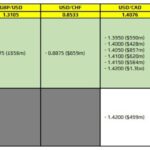
Mastering FX Option Expiries: Essential Trends and Strategies for April 2025
Tháng 4 4, 2025
Trump’s ‘Liberation Day’ Tariffs: Navigating the Turmoil in Global Markets
Tháng 4 4, 2025JPMorgan Chase Boosts Global Recession Odds to 60% by 2025: What This Means for the Economy
JPMorgan Chase has recently revised its forecast for the likelihood of a global recession, now estimating a significant 60% chance by the end of 2025. This adjustment marks a notable increase from previous expectations of just 40%. The banking giant’s forecast has raised eyebrows in the financial community, as it reflects deeper concerns regarding ongoing global economic stability, market dynamics, and policy shifts.
Influencing Factors Behind the Increased Recession Odds
Several key factors have contributed to this heightened outlook on recession risks. The shift in predictions aligns with recent market volatility that has seen various global economies facing pressure. The unpredictability in stock markets, fluctuating commodity prices, and wavering consumer confidence all play critical roles in shaping these forecasts. Moreover, long-lasting effects from geopolitical tensions and economic policies — particularly those implemented during previous administrations, such as the tariffs imposed by former President Donald Trump — continue to have reverberating impacts on international trade and market stability.
In the wake of these developments, national banks and financial institutions, including JPMorgan and Goldman Sachs, have been closely monitoring economic indicators and market behaviors. The conversations among financial professionals on social media platforms reveal that the sentiment toward a looming recession is gaining traction, stimulating discussions on potential outcomes and strategies for navigating the next few years of economic uncertainty.
Implications for Global Markets and Investors
The new recession assessment from JPMorgan reflects a cautious approach to future investment decisions. For investors, this heightened probability suggests a period of increased risk and volatility in the markets. Asset managers and retail investors alike are advised to consider risk management strategies as this forecast may lead to fluctuations in stock prices, currency stability, and the commodities market.
Furthermore, financial analysts are likely to delve deeper into the underlying economic indicators that could further validate or challenge JPMorgan’s projections. Indicators such as inflation rates, employment figures, consumer spending, and international trade policies will likely come under greater scrutiny as analysts seek to understand the prospect of a global downturn.
For those looking for a comprehensive analysis of JPMorgan’s updated forecast and its broader implications for global markets, resources like the article from ForexLive provide essential insights. Engaging with such analyses can give investors and economic observers a more nuanced understanding of the current financial landscape and inform their decisions moving forward. Additionally, understanding key investment mistakes to avoid during such turbulent times is crucial. For instance, reviewing insights from this article on investment mistakes to avoid could be beneficial.
As we navigate through this period of uncertainty, staying informed about shifts in economic projections from major financial institutions like JPMorgan Chase becomes essential. The possibility of a 60% chance of a global recession by 2025 reflects not just calculations but also the sentiment among financial professionals regarding the state of the world economy—a sentiment that merits careful consideration as we embrace the future. For a deeper understanding of strategic investment during downturns, consider understanding the tenets of value investing as highlighted here.

